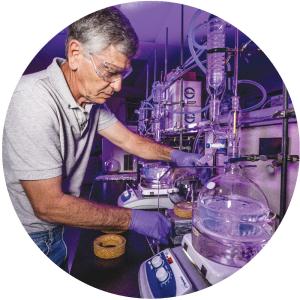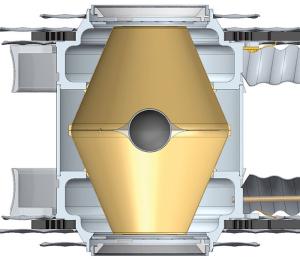Supporting stockpile stewardship through a wide range of experiments and pursuit of laser fusion ignition, and operating as a national user facility for high-energy-density science
Experiments resumed at the National Ignition Facility (NIF) on April 26, 2020, following cessation of all but critical activities at LLNL in mid-March due to the COVID-19 pandemic. The NIF team worked closely with the Health Services Department and environment, health, and safety experts to rapidly develop new protocols to enable operations with the health and safety of workers set as the highest priority. Although limited by the downtime and current operational restrictions, NIF completed 327 experiments in FY 2020, including many critical tests in support of stockpile stewardship.
Stockpile Stewardship HED Science Experiments
NIF high-energy-density (HED) science experiments in FY 2020 provided crucial data about the properties of plutonium and in support stockpile modernization programs. The NIF HED material science team studied the structure and strength of unshocked plutonium squeezed to the highest pressure yet achieved in a ramp-compression diffraction experiment. Other experiments, conducted by a Sandia National Laboratories team with LLNL scientists, collected data to validate codes used to assess weapons system survivability in hostile environments. Many tests jointly address challenges arising in stockpile modernization, underlying weapons physics issues, and the pursuit of inertial confinement fusion ignition. The data are used to improve and validate 3D simulation models of weapons performance.
Progress in Pursuing Fusion Ignition
Achieving fusion ignition and energy gain at NIF is a grand scientific challenge. Significant progress is being made through a combination of data from experiments and improved simulation capabilities (see Supercomputing with AI). Efforts this year directly supported NNSA’s 2020 report to evaluate the path forward for inertial confinement fusion (ICF) research. Laboratory scientists completed a series of 3D simulations and massive ensembles of 2D simulations coupled to machine learning (ML) for the purpose of estimating uncertainties in predictions of ignition with multi-megajoule lasers. A series of 3D simulations was also run for an experimentally tested target design and the good agreement between simulations and experimental results across a range of observables provided reassuring validation. This work used LLNL’s leading-edge ML tool that is helping to guide decisions about target design, future experiments to conduct, and upgrades to codes and diagnostic improvements.
NIF experiments have led to a greater understanding of the factors currently limiting overall performance. ICF implosions have been slightly off-center, which degrades hot-spot conditions and reduces fusion yield. The diagnostic windows in the holhraum (which surrounds the target capsule) were identified as an important contributing factor to this asymmetry. Redesign options are being studied. In addition, mixing of ablator material into the hot spot has been reduced significantly by decreasing the diameter of the deuterium–tritium fill tube from 10 micrometers to 2 micrometers. Methods such as adjustments to laser pulse shape, ablator versus fuel thickness, and dopants in the ablator are being considered to further reduce mixing. Experiments have also explored alternative designs of the hohlraum that would permit spherical implosion of larger target capsules and delivery of more energy to the hot spot. Recent tests resulted in record-setting neutron yields and show promise for further improvement.
Improved Diagnostics
The Stockpile Stewardship Program is greatly benefiting from remarkable advances in diagnostics that support HED experiments at NIF. These improvements have made possible precision HED material science experiments studying equation of state (EOS), x-ray diffraction to study crystalline structure, and material strength. In addition, these new instruments are helping scientists develop a clearer understanding of what is happening in an ICF implosion. LLNL and partner laboratories and universities have designed and built an extensive suite of nuclear diagnostics. Together they aim to provide a comprehensive picture of implosion performance and have enabled the aforementioned recent advances.
One especially important advance in FY 2020 was creation of the first time-resolved Compton radiograph of an ICF implosion. The technique entails use of the Advanced Radiographic Capability laser to create two intense bursts of high-energy x rays that Compton scatter off electrons in the fuel plasma. At different times (100 to 200 picoseconds apart) during the implosion, the diagnostic creates radiographs of the highly compressed fuel. Compton radiography will find many additional applications supporting stockpile stewardship and is ideal for studying the EOS of low-Z materials at extreme conditions.
Discovery Science at NIF
Discovery Science experiments at NIF provide unique opportunities to explore the conditions found at the cores of giant planets and the interior of brown dwarfs (failed stars), and other energetic phenomena in the universe. In FY 2020, researchers used NIF to collide a pair of plasma flows traveling at 1,500 kilometers per second and create a supernova-remnant-like shock, which accelerates electrons to nearly the speed of light, as predicted. EOS experiments created the highest pressures thus far achieved in a controlled laboratory experiment. Scientists successfully conducted the first studies of matter at the conditions in the outer carbon layer of an unusual class of white dwarf stars, gathering data that agreed with current EOS models. In addition, a team of LLNL and Los Alamos researchers devised an innovative technique to apply data about plasma conditions created in ICF experiments to gain valuable insights into the makeup of brown dwarfs.
Plasma Science Decadal Report
In May 2020, the National Academy of Sciences, Engineering and Medicine released its Plasma Science Decadal Report, an assessment of the state and future of plasma sciences. NIF was prominently featured in the report as the source of multiple breakthroughs in HED plasma science. The report called for a national commitment to build the successors to today’s largest experimental capabilities to continue U.S. leadership in plasma science and tackle identified grand challenges








